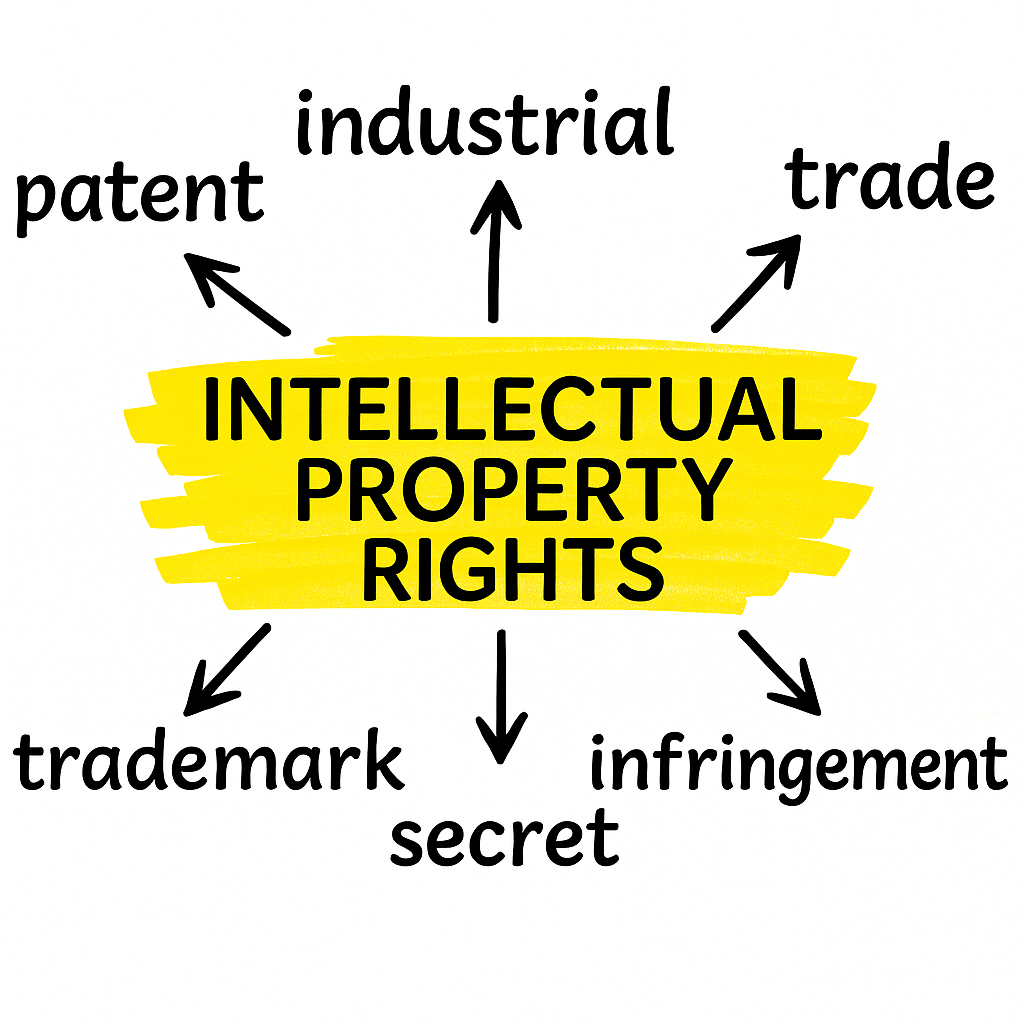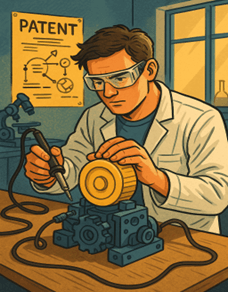
By, Eduardo Napoli Lecturer in Criminology – FSB Croydon
In today’s knowledge-driven economy, intellectual property (IP) serves as the lifeblood of competitive advantage. For business leaders and entrepreneurs, correctly understanding and managing IP rights isn’t just a matter of legal compliance; it’s a strategic imperative that can significantly impact market position, revenue streams, and long-term viability. Whether protecting innovative products, distinctive brands, or creative content, IP rights transform intangible ideas into valuable business assets. The most critical forms of IP protection – including patents, trademarks, copyrights, design rights, and geographical indications – each serve as specialised tools to safeguard different manifestations of intellectual capital. These legal frameworks don’t merely protect creations; they enable businesses to capitalise on their innovation investments while preventing unauthorised exploitation by competitors.
The World Intellectual Property Organisation1, a specialised agency of the United Nations with 193 member states, was created to advance global intellectual property development. It defines intellectual property2 (IP) as creations of the mind, including inventions, literary and artistic works, designs, symbols, names, and images used commercially. Creators can be granted rights to prevent others from using their inventions, designs, or other creations. These rights are commonly referred to as intellectual property rights.

Intellectual property protections are established by law to ensure creators of patents, copyrights, designs, or trademarks can earn financial rewards for their work (Landes & Posner, 2003). However, it’s crucial to remember that such protections require a formal application and registration process. This legal step helps prevent others from using the invention without permission. It allows the original creator, who has invested time, effort, and personal ideas, to benefit financially from their creative work (Merges, 2011).
It also applies to a company that hires scientists, engineers, and professionals from various fields to develop a product under its name, aiming to explore this product in the market for up to 20 years of patent protection (sometimes plus an additional 5 years of invention monopoly). The patent owner is the individual registered as the proprietor. Employees often create inventions, and in such cases, the employer is typically the proprietor, even though the patent will list the invention under the employee’s name. (Bainbridge, 2012)

If an employee’s creation provides a significant benefit to the employer, the employee may be eligible for compensation under Article 40(1) of the UK Patents Act3 1977, particularly when the invention belongs to the employer. Although intellectual property rights protect creators and grant them exclusive use for several years, they also act as a barrier by preventing others from exploring or utilising the product without permission from the rights holder (Bently & Sherman, 2014). No one can commercially exploit the creation without approval.
UK Intellectual Property Laws
In the United Kingdom, various legal instruments regulate intellectual property rights, including the Copyright, Designs and Patents Act 1988; the Patents Act 1977; the Registered Designs Act 1986; the Trademarks Act 1994; the Public Leading Rights Act 1979; and the Plant Varieties Act 1997, among others. Under the UK Patents Act 19774 Article 1 (1) of the UK legislation, which governs this type of intellectual property rights, describes a patent as follows:
1.-(1) A patent may be granted only for an invention in respect of which the following conditions are satisfied, that is to say –
(a) the invention is new;
(b) it involves an inventive step;
(c) it is capable of industrial application;
(d) the grant of a patent for it is not excluded by subsections (2) and (3) or section 4A below; and references in this Act to a patentable invention shall be construed accordingly.
The UK Patents Act 1977 also stipulates that not all inventions can be patented. To be granted, pursuant to article 1 (3)5, a patent will not be granted if it is not according to the public police or morality:
‘(3) A patent shall not be granted for an invention the commercial exploitation of which would be contrary to public policy or morality.’
As previously mentioned, the employee’s right to receive compensation for their work, particularly when their invention or creation significantly benefits the employer (such as a pharmaceutical company), is also incorporated in the UK Patents Act 1977, pursuant to article 40 (1)6 and article 41 (1)7 (a) (b), which states that:
40.-(1) Where it appears to the court or the comptroller on an application made by an employee within the prescribed period that –
(a) the employee has made an invention belonging to the employer for which a patent has been granted,
(b) having regard among other things to the size and nature of the employer’s undertaking, the invention or the patent for it (or the combination of both) is of outstanding benefit to the employer, and
(c) by reason of those facts it is just that the employee should be awarded compensation to be paid by the employer, the court or the comptroller may award him such compensation of an amount determined under section 41 below.
41.-(1) An award of compensation to an employee under section 40(1) or (2) above shall be such as will secure for the employee a fair share (having regard to all the circumstances) of the benefit which the employer has derived, or may reasonably be expected to derive, from any of the following –
(a) the invention in question;
(b) the patent for the invention;
The legal provisions under the UK Patents Act 19778 guarantee that the intangible property created, once legally registered pursuant to its articles 14, 15, and 16, is protected by law and can be the subject of an action for infringement in the event of a violation.
Robust intellectual property protections serve as a critical foundation for innovation by ensuring that creators can secure the economic returns on their investments, particularly in high-stakes industries like pharmaceuticals, where decades of research and millions of dollars in development costs hinge on legal safeguards (Bently & Sherman, 2014; Davis, 2022). Without these protections, competitors might exploit original innovations without contributing, which could undermine motivation for future breakthroughs and distort market competition (Landes & Posner, 2003b; Merges, 2011b).
Ultimately, IP rights not only reward individual creativity but also support an ecosystem that encourages long-term investment in knowledge and innovation. This balance between private incentives and societal progress is crucial. A well-designed IP system promotes innovation and public benefit, playing a vital role in fostering economic growth, cultural development, and technological progress in a world that increasingly depends on knowledge.
Bibliography
Bainbridge, D. (2012) Intellectual property. 9th edn. Harlow: Pearson Education.
Bently, L. and Sherman, B. (2014) Intellectual property law. 4th edn. Oxford: Oxford University Press.
Boyle, J. (2008) The Public Domain: Enclosing the Commons of the Mind. New Haven: Yale University Press.
Davis, J. (2022) Intellectual property law. 8th edn. Oxford: Oxford University Press.
Drahos, P. (2016) A Philosophy of Intellectual Property. 2nd edn. London: Routledge.
Heller, M.A. (2008) The Gridlock Economy: How Too Much Ownership Wrecks Markets, Stops Innovation, and Costs Lives. New York: Basic Books.
Intellectual Property Law – Janifer Davis – 4th edition – the ‘Law and Economics’ justification.
Landes, W.M. and Posner, R.A. (2003) The economic structure of intellectual property law. Cambridge, MA: Harvard University Press.
Lemley, M.A. (2015) Faith-Based Intellectual Property. UCLA Law Review, 62(5), pp. 1328–1346.
Lessig, L. (2004) Free Culture: How Big Media Uses Technology and the Law to Lock Down Culture and Control Creativity. New York: Penguin Press.
Maskus, K.E. (2000) Intellectual Property Rights in the Global Economy. Washington, DC: Institute for International Economics.
Merges, R.P. (2011) Justifying intellectual property. Cambridge, MA: Harvard University Press.
Stiglitz, J.E. (2008) Economic Foundations of Intellectual Property Rights. Duke Law Journal, 57(6), pp. 1693–1724.
UK Patents Act 1977 – Part I – New domestic law – article 1 (1).
United Nations (2023) Specialised agencies and partners. Available at: https://www.un.org/en/about-us/specialized-agencies (Accessed: July 11th 2025).
WIPO (2021) Understanding industrial property. Available at: https://www.wipo.int/edocs/pubdocs/en/wipo_pub_895_2021.pdf (Accessed: July 10th 2025).
World Intellectual Property Organization (WIPO) (2022) What is intellectual property? Available at: https://www.wipo.int/about-ip/en/ (Accessed: July 10th 2025).
